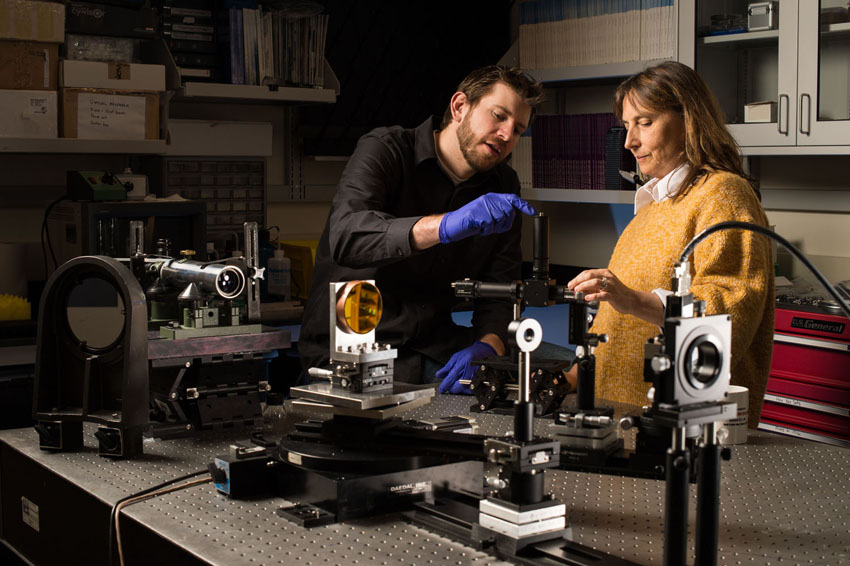Kyle Fuerschbach receives Kevin P. Thompson award from OSA
March 25, 2019

Kyle Fuerschbach, in 2013 photo, shown in lab with Professor Jannick Rolland. (Photo by J. Adam Fenster/University of Rochester)
Kyle Fuerschbach, who received his PhD from the Institute of Optics in 2014, has been selected as the 2019 recipient of The Optical Society (OSA) Kevin P. Thompson Optical Design Innovator Award.
The award, named in honor of one of Kyle’s mentors, recognizes contributions to lens design, optical engineering, or metrology at an early career stage.
Kyle, now a senior member of the technical staff of the optics and sensors engineering group at Sandia National Laboratories, is being honored for his ground-breaking work in the development of freeform optical surfaces to create optical devices that are that are lighter, more compact, and more effective than ever before. Applications include 3-D imaging and visualization, augmented and virtual reality, infrared and military optical systems, efficient automotive and LED lighting, energy research, remote sensing, semiconductor manufacturing and inspection, and medical and assistive technologies.
Specifically, Kyle is recognized for using Nodal Aberration Theory to design, manufacture, and test a fully functional first-ever free form imaging telescope in a fully rotationally nonsymmetric configuration, demonstrating revolutionary freeform surfaces in optical imaging systems.
The award is named in honor of the late Kevin Thompson, a former scientist at the Institute of Optics and group director, Research and Development/Optics at Synopsys, Inc., whose many other accomplishments include leading breakthroughs in the understanding of the aberration fields of a new class of truly non-symmetric optical systems using freeform optical surfaces.
An historic observation
Fundamental to the process of the optical design of complex lenses, from cell phone cameras to the optics that manufacture computer chips, is a guiding theory of the field dependence of the characteristic aberrations (spherical aberration, coma, astigmatism…) which was developed over a period of 150 years, starting in 1825. The theory that emerged and still dominates today has a strict condition that the optical surfaces are all rotationally symmetric. In the early 2000’s, optical surface manufacturers developed the ability to create rotationally nonsymmetric surfaces for use at infrared wavelengths. Suddenly, there was an ability to manufacture surfaces for which there was no underlying aberration theory to guide the optical design process.
In 2011, Kyle was performing a computer simulation that placed a common rotationally nonsymmetric surface deformation (trefoil) on a computer model of the James Webb Space Telescope (JWST). During the simulation Kyle noted a graphical aberration field behavior that he traced to a vector-based aberration theory, Nodal Aberration Theory, developed by Kevin Thompson in 1979 during his PhD thesis advised by Professor Roland Shack. The observation by Kyle was historic. It solved an analytic puzzle that had been worked on by leaders in the field for over 100 years. His one observation extrapolates immediately to the missing aberration theory of rotationally nonsymmetric surfaces, which today are the revolutionary field of freeform optics and the basis for the recently created NSF I/UCRC Center for Freeform Optics directed by Professor Jannick Rolland, Kyle’s PhD primary advisor. This connection would not have been made in this era without Kyle’s insight.
Kyle went on in his PhD work, co-advised by Professor Rolland and Dr. Kevin Thompson, to complete an expanded NAT theory for freeform optics. He also co-invented, devised, manufactured the components for, assembled, and aligned an optical system to conclusively show the validity of his discovery and additionally to design, specify, test, and assemble a first imaging optical system to exploit the new theory. Kyle published his work in Optics Letters and Optics Express in a series of four papers. He received the Outstanding Dissertation Award in Engineering and Applied Sciences for 2014-2015.
